外研版 英语 七年级下册 Module 11Body language Unit 3 习题课件(共25张PPT)
文档属性
| 名称 | 外研版 英语 七年级下册 Module 11Body language Unit 3 习题课件(共25张PPT) | 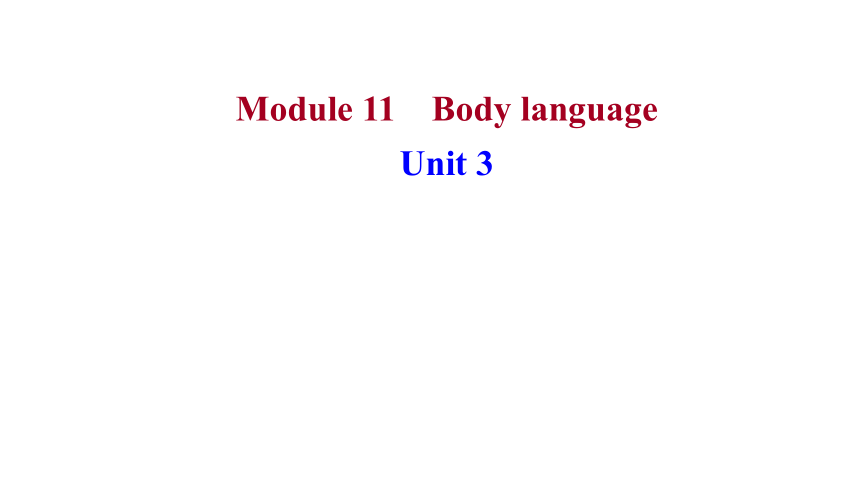 | |
| 格式 | ppt | ||
| 文件大小 | 420.5KB | ||
| 资源类型 | 教案 | ||
| 版本资源 | 外研版 | ||
| 科目 | 英语 | ||
| 更新时间 | 2022-06-09 14:52:55 | ||
图片预览


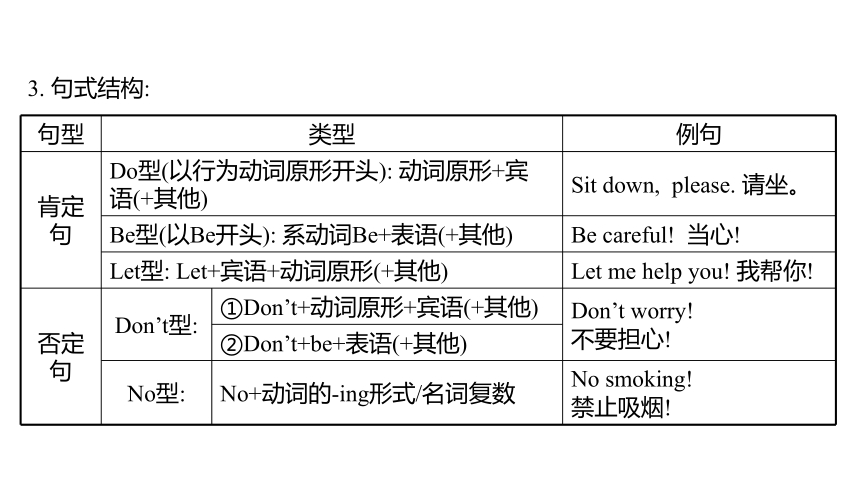

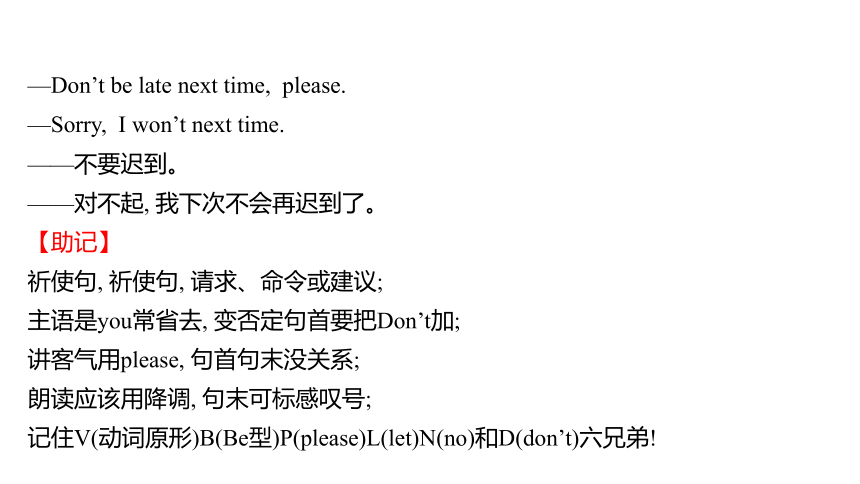

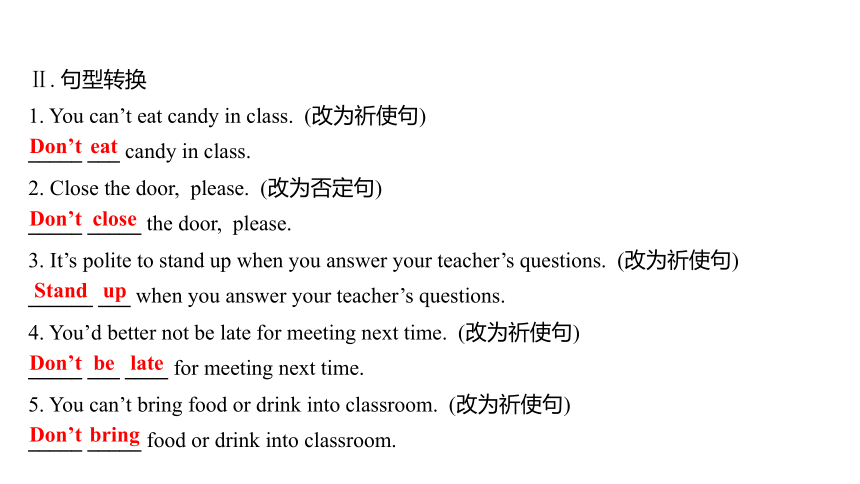
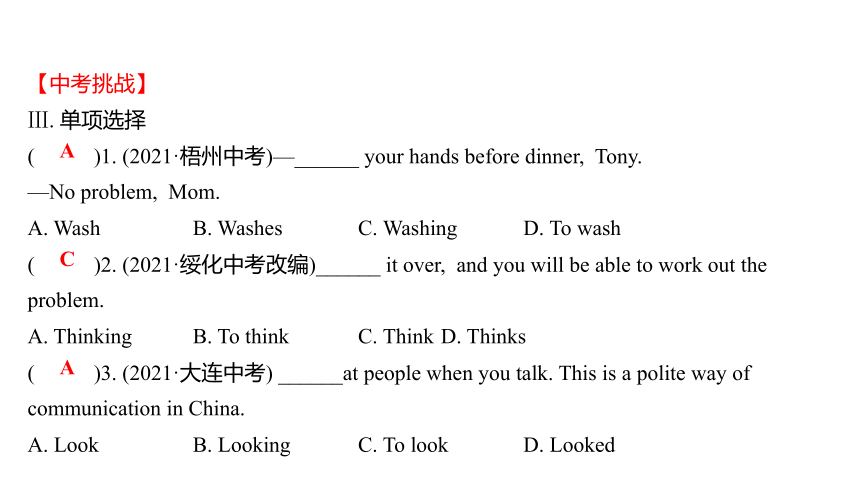
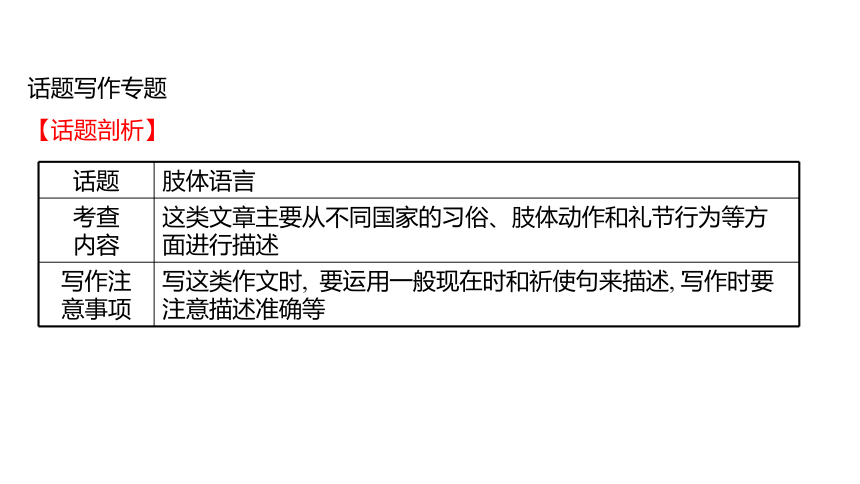
文档简介
(共25张PPT)
Module 11 Body language
Unit 3
模块语法专题
【语法精讲】
祈使句
1. 概念: 祈使句是用来表达请求、叮嘱、希望、命令、禁止、劝告、建议等的句子。
2. 特点: (1)祈使句常以动词原形开头, 没有时态和数的变化。
(2)变否定句时通常在句首加Don’t。
(3)通常省略主语you, 在表达请求时, 可以加上please, 表达强烈语气时, 可以加上感叹号, 读时用降调。
3. 句式结构:
句型 类型 例句
肯定句 Do型(以行为动词原形开头): 动词原形+宾
语(+其他) Sit down, please. 请坐。
Be型(以Be开头): 系动词Be+表语(+其他) Be careful! 当心!
Let型: Let+宾语+动词原形(+其他) Let me help you! 我帮你!
否定句 Don’t型: ①Don’t+动词原形+宾语(+其他) Don’t worry!
不要担心!
②Don’t+be+表语(+其他)
No型: No+动词的-ing形式/名词复数 No smoking!
禁止吸烟!
4. 祈使句的答语:
祈使句通常表示将要发生的动作, 所以回答时一般借助于will或won’t。
回答肯定的祈使句用Yes, I/we will. 。
回答否定的祈使句用Sorry, I/we won’t. 。
—Close the door, please.
—Yes, I will.
——请关上门!
——好的, 我会的。
—Don’t be late next time, please.
—Sorry, I won’t next time.
——不要迟到。
——对不起, 我下次不会再迟到了。
【助记】
祈使句, 祈使句, 请求、命令或建议;
主语是you常省去, 变否定句首要把Don’t加;
讲客气用please, 句首句末没关系;
朗读应该用降调, 句末可标感叹号;
记住V(动词原形)B(Be型)P(please)L(let)N(no)和D(don’t)六兄弟!
【语法专练】
【基础演练】
Ⅰ. 用所给词的适当形式填空
1. It’s an important meeting. ________(not be) late.
2. __________(not draw) everywhere when you go travelling! Try to be a polite
student!
3. _____(look) out! A car is coming.
4. ___________(not make) the baby cry. It’s too noisy.
5. ______(work) hard, and you’ll make more progress.
Don’t be
Don’t draw
Look
Don’t make
Work
Ⅱ. 句型转换
1. You can’t eat candy in class. (改为祈使句)
_____ ___ candy in class.
2. Close the door, please. (改为否定句)
_____ _____ the door, please.
3. It’s polite to stand up when you answer your teacher’s questions. (改为祈使句)
______ ___ when you answer your teacher’s questions.
4. You’d better not be late for meeting next time. (改为祈使句)
_____ ___ ____ for meeting next time.
5. You can’t bring food or drink into classroom. (改为祈使句)
_____ _____ food or drink into classroom.
Don’t
eat
Don’t
close
Stand
up
Don’t
be
late
Don’t
bring
【中考挑战】
Ⅲ. 单项选择
( )1. (2021·梧州中考)—______ your hands before dinner, Tony.
—No problem, Mom.
A. Wash B. Washes C. Washing D. To wash
( )2. (2021·绥化中考改编)______ it over, and you will be able to work out the
problem.
A. Thinking B. To think C. Think D. Thinks
( )3. (2021·大连中考) ______at people when you talk. This is a polite way of
communication in China.
A. Look B. Looking C. To look D. Looked
A
C
A
话题写作专题
【话题剖析】
话题 肢体语言
考查
内容 这类文章主要从不同国家的习俗、肢体动作和礼节行为等方
面进行描述
写作注
意事项 写这类作文时, 要运用一般现在时和祈使句来描述, 写作时要
注意描述准确等
【语用储备】
读·教材佳句
1. That’s because people do different things in different countries.
2. In the US some people shake hands, and some kiss or hug each other.
3. Give them more personal space.
4. It isn’t polite to look at people when you talk.
5. Don’t stand too close to North Americans.
仿·万能句式
1. 那是因为不同的国家有不同的风俗。
___________________________________________________
2. 在中国, 当你见到游客的时候, 你应该握手。
__________________________________________________
3. 在西方国家, 你应该给他们更多的个人空间。
_________________________________________________________
4. 冲别人微笑是很有礼貌的。
_________________________
That’s because different countries have different customs.
In China, when you see tourists, you should shake hands.
In western countries, you should give them more personal space.
It’s polite to smile at others.
【类题仿写】
假如你是一名导游, 你将带团去泰国观光。根据下面所给的提示, 写一篇短文, 告诉游客泰国的一些风俗。
1. 不要触摸他人头部;
2. 与别人谈话时, 不要用手指着对方;
3. 参观寺院时, 男士要穿衬衫和鞋子;
4. 不能手指僧侣, 女性不能与僧侣握手。
提示词汇: 泰国Thailand, 风俗 custom, 寺院temple, 僧侣 monk
要求: 1. 条理清晰、意思连贯、语句通顺、标点正确;
2. 50~60词。
【考场·答题流程】
Step 1: “五定”审题
定体裁 ①______ 定人称 ②第__人称
定时态 ③以_________为主
定要点
定结构 ④概括说明
⑤详细介绍
⑥总结归纳
说明文
二
一般现在时
Step 2: “三段”谋篇
第一段: 点明主题
1. 不同国家的人们做不同的事情。(different)
_________________________________________
第二段: 详细介绍风俗。
2. 首先, 不要触摸别人的头。(touch one’s head)
____________________________
3. 第二, 当你和别人交谈时, 不要用手指着他们。(talk to)
____________________________________________________________
People in different countries do different things.
First, don’t touch others’ heads.
Second, don’t point at others with your finger when you talk to them.
4. 第三, 男人在参观寺庙时应该穿衬衫和鞋子。(temples)
_______________________________________________________
5. 第四, 不要手指僧侣, 女人不能和他们握手。(shake hands)
__________________________________________________________________
__________
第三段: 总结归纳。
6. 你应该记住: 入乡随俗。(Rome; Romans)
_____________________________________________________
Third, men should wear shirts and shoes when visiting temples.
Fourth, don’t point at monks with your finger and women can’t shake hands
with them.
You should remember: When in Rome, do as the Romans do.
Step 3: 完美成篇
__________________________________________________________________
__________________________________________________________________
__________________________________________________________________
【参考范文】
People in different countries do different things. Before going to other countries, you should know some customs.
If you go to Thailand, you should know these customs there. First, don’t touch others’ heads. That’s because it’s not polite at all. Second, don’t point at others with your finger when you talk to them. Third, men should wear shirts and shoes when visiting temples. Fourth, don’t point at monks with your finger and women can’t shake hands with them.
You should remember: When in Rome, do as the Romans do.
易错易混练
易错点1: not at all的用法
( )①—Thank you very much.
—____
A. Don’t say so. B. The same to you.
C. Not at all. D. With pleasure.
( )②People in China ______like to hug each other ______.
A. not; at all B. no; at all
C. don’t; any more D. don’t; at all
【易错归纳】
1. not. . . at all分开用, 意为“根本不; 一点儿也不”。
2. Not at all用于交际用语中, 常用来回答Thank you。
C
D
易错点2: each与every 的用法
( )①When we have different ideas, we should understand ______.
A. each other B. one other C. each one D. every one
( )②They all live together in a three-bedroom house, but ______of them is
happy.
A. with B. and C. together D. each
( )③Gina has piano lessons ______ two weeks.
A. every B. each C. another D. either
A
D
A
④我们班里每个人都有一本词典。
______________________________
【易错归纳】
1. each指代两个或两个以上的人或事物中的每个。作形容词修饰单数名词, 后
接单数动词。
2. each作代词, 可以单独使用, 作主语时后接单数动词; 放在复数名词和代词后
作同位语, 后接复数动词。each of后接的名词或代词必须是复数, 而不能是单数;
其后接名词必须要有冠词、物主代词、指示代词等之类的限定词修饰。
3. every指代三者或三者以上, 可以作形容词, 后接名词, 但不能单独作主语。
Each has a dictionary in our class.
综合能力练
Ⅰ. 选词填空
teacher answers are enjoyed don’t asks stay him speaking first
Do you meet problems when you live in the USA To this question, many
students think rules (规矩) can help them work it out. They think rules for dinner
and school rules 1. ___important to them. Now, let’s learn some together.
Rules for dinner
When your friend 2. ____you to come to a party, don’t be too late or too early
to get there. It’s OK to be 10 to 15 minutes late.
After dinner, it’s nice to 3. ____for minutes. When your friend looks tired, you
can say goodbye to 4. ____and go home.
are
asks
stay
him
teacher answers are enjoyed don’t asks stay him speaking first
When you go back home, you can say “Thank you” to your friend. Or, the next day,
you can call or write a thank-you note to say how much you 5. _______the evening.
Rules for you at school
You 6. _____need to say hello to your teacher when you come into a very big class. If
you are late for class, you must go into the classroom quietly (安静地). But you have to say
sorry to the 7. _______when the class is over.
Don’t talk when your classmate is 8. ________. If you have something to say, you
have to let your classmate finish speaking 9. ____. It’s not good to keep quiet when your
teacher asks you questions. If you don’t know the 10. _______, you can say “I’m sorry”.
enjoyed
don’t
teacher
speaking
first
answers
Ⅱ. 阅读理解
Dogs have feelings. They can feel happy, sad and worried, just like we do.
Here are some photos that show you dogs with different feelings. Arrows (箭头) pointing to the body part tell us whether (是否) the dog is happy or not.
The most important part showing dogs’ feelings is the mouth. If the dog is panting (气喘吁吁) and shaking his tail, he is most likely feeling relaxed. He may want to play with you. If he feels worried or uncomfortable, then his mouth is closed. You’d better leave him alone.
You may notice that some of the arrows point to a leash (皮带). A tight leash tells you that the dog is not relaxed. Remember to stay away from a dog on a tight leash!
( )1. What should you do when a dog is panting and shaking his tail
A. Look at it. B. Play with it.
C. Leave it alone. D. Stay away from it.
( )2. Which is the most important part showing a dog’s feelings
A. Ears. B. Eyes.
C. The tail. D. The mouth.
( )3. Which picture can tell you that the dog is saying “Let’s make friends”
A. Picture 1. B. Picture 2.
C. Picture 3. D. Picture 4.
B
D
D
( )4. What does the underlined word “tight” in the last paragraph mean
A. 紧张的 B. 紧的
C. 结实的 D. 松弛的
( )5. What’s the best title for this passage
A. Dogs’ feelings
B. How to protect dogs
C. Dogs’ body language
D. How to make friends with dogs
B
C
Module 11 Body language
Unit 3
模块语法专题
【语法精讲】
祈使句
1. 概念: 祈使句是用来表达请求、叮嘱、希望、命令、禁止、劝告、建议等的句子。
2. 特点: (1)祈使句常以动词原形开头, 没有时态和数的变化。
(2)变否定句时通常在句首加Don’t。
(3)通常省略主语you, 在表达请求时, 可以加上please, 表达强烈语气时, 可以加上感叹号, 读时用降调。
3. 句式结构:
句型 类型 例句
肯定句 Do型(以行为动词原形开头): 动词原形+宾
语(+其他) Sit down, please. 请坐。
Be型(以Be开头): 系动词Be+表语(+其他) Be careful! 当心!
Let型: Let+宾语+动词原形(+其他) Let me help you! 我帮你!
否定句 Don’t型: ①Don’t+动词原形+宾语(+其他) Don’t worry!
不要担心!
②Don’t+be+表语(+其他)
No型: No+动词的-ing形式/名词复数 No smoking!
禁止吸烟!
4. 祈使句的答语:
祈使句通常表示将要发生的动作, 所以回答时一般借助于will或won’t。
回答肯定的祈使句用Yes, I/we will. 。
回答否定的祈使句用Sorry, I/we won’t. 。
—Close the door, please.
—Yes, I will.
——请关上门!
——好的, 我会的。
—Don’t be late next time, please.
—Sorry, I won’t next time.
——不要迟到。
——对不起, 我下次不会再迟到了。
【助记】
祈使句, 祈使句, 请求、命令或建议;
主语是you常省去, 变否定句首要把Don’t加;
讲客气用please, 句首句末没关系;
朗读应该用降调, 句末可标感叹号;
记住V(动词原形)B(Be型)P(please)L(let)N(no)和D(don’t)六兄弟!
【语法专练】
【基础演练】
Ⅰ. 用所给词的适当形式填空
1. It’s an important meeting. ________(not be) late.
2. __________(not draw) everywhere when you go travelling! Try to be a polite
student!
3. _____(look) out! A car is coming.
4. ___________(not make) the baby cry. It’s too noisy.
5. ______(work) hard, and you’ll make more progress.
Don’t be
Don’t draw
Look
Don’t make
Work
Ⅱ. 句型转换
1. You can’t eat candy in class. (改为祈使句)
_____ ___ candy in class.
2. Close the door, please. (改为否定句)
_____ _____ the door, please.
3. It’s polite to stand up when you answer your teacher’s questions. (改为祈使句)
______ ___ when you answer your teacher’s questions.
4. You’d better not be late for meeting next time. (改为祈使句)
_____ ___ ____ for meeting next time.
5. You can’t bring food or drink into classroom. (改为祈使句)
_____ _____ food or drink into classroom.
Don’t
eat
Don’t
close
Stand
up
Don’t
be
late
Don’t
bring
【中考挑战】
Ⅲ. 单项选择
( )1. (2021·梧州中考)—______ your hands before dinner, Tony.
—No problem, Mom.
A. Wash B. Washes C. Washing D. To wash
( )2. (2021·绥化中考改编)______ it over, and you will be able to work out the
problem.
A. Thinking B. To think C. Think D. Thinks
( )3. (2021·大连中考) ______at people when you talk. This is a polite way of
communication in China.
A. Look B. Looking C. To look D. Looked
A
C
A
话题写作专题
【话题剖析】
话题 肢体语言
考查
内容 这类文章主要从不同国家的习俗、肢体动作和礼节行为等方
面进行描述
写作注
意事项 写这类作文时, 要运用一般现在时和祈使句来描述, 写作时要
注意描述准确等
【语用储备】
读·教材佳句
1. That’s because people do different things in different countries.
2. In the US some people shake hands, and some kiss or hug each other.
3. Give them more personal space.
4. It isn’t polite to look at people when you talk.
5. Don’t stand too close to North Americans.
仿·万能句式
1. 那是因为不同的国家有不同的风俗。
___________________________________________________
2. 在中国, 当你见到游客的时候, 你应该握手。
__________________________________________________
3. 在西方国家, 你应该给他们更多的个人空间。
_________________________________________________________
4. 冲别人微笑是很有礼貌的。
_________________________
That’s because different countries have different customs.
In China, when you see tourists, you should shake hands.
In western countries, you should give them more personal space.
It’s polite to smile at others.
【类题仿写】
假如你是一名导游, 你将带团去泰国观光。根据下面所给的提示, 写一篇短文, 告诉游客泰国的一些风俗。
1. 不要触摸他人头部;
2. 与别人谈话时, 不要用手指着对方;
3. 参观寺院时, 男士要穿衬衫和鞋子;
4. 不能手指僧侣, 女性不能与僧侣握手。
提示词汇: 泰国Thailand, 风俗 custom, 寺院temple, 僧侣 monk
要求: 1. 条理清晰、意思连贯、语句通顺、标点正确;
2. 50~60词。
【考场·答题流程】
Step 1: “五定”审题
定体裁 ①______ 定人称 ②第__人称
定时态 ③以_________为主
定要点
定结构 ④概括说明
⑤详细介绍
⑥总结归纳
说明文
二
一般现在时
Step 2: “三段”谋篇
第一段: 点明主题
1. 不同国家的人们做不同的事情。(different)
_________________________________________
第二段: 详细介绍风俗。
2. 首先, 不要触摸别人的头。(touch one’s head)
____________________________
3. 第二, 当你和别人交谈时, 不要用手指着他们。(talk to)
____________________________________________________________
People in different countries do different things.
First, don’t touch others’ heads.
Second, don’t point at others with your finger when you talk to them.
4. 第三, 男人在参观寺庙时应该穿衬衫和鞋子。(temples)
_______________________________________________________
5. 第四, 不要手指僧侣, 女人不能和他们握手。(shake hands)
__________________________________________________________________
__________
第三段: 总结归纳。
6. 你应该记住: 入乡随俗。(Rome; Romans)
_____________________________________________________
Third, men should wear shirts and shoes when visiting temples.
Fourth, don’t point at monks with your finger and women can’t shake hands
with them.
You should remember: When in Rome, do as the Romans do.
Step 3: 完美成篇
__________________________________________________________________
__________________________________________________________________
__________________________________________________________________
【参考范文】
People in different countries do different things. Before going to other countries, you should know some customs.
If you go to Thailand, you should know these customs there. First, don’t touch others’ heads. That’s because it’s not polite at all. Second, don’t point at others with your finger when you talk to them. Third, men should wear shirts and shoes when visiting temples. Fourth, don’t point at monks with your finger and women can’t shake hands with them.
You should remember: When in Rome, do as the Romans do.
易错易混练
易错点1: not at all的用法
( )①—Thank you very much.
—____
A. Don’t say so. B. The same to you.
C. Not at all. D. With pleasure.
( )②People in China ______like to hug each other ______.
A. not; at all B. no; at all
C. don’t; any more D. don’t; at all
【易错归纳】
1. not. . . at all分开用, 意为“根本不; 一点儿也不”。
2. Not at all用于交际用语中, 常用来回答Thank you。
C
D
易错点2: each与every 的用法
( )①When we have different ideas, we should understand ______.
A. each other B. one other C. each one D. every one
( )②They all live together in a three-bedroom house, but ______of them is
happy.
A. with B. and C. together D. each
( )③Gina has piano lessons ______ two weeks.
A. every B. each C. another D. either
A
D
A
④我们班里每个人都有一本词典。
______________________________
【易错归纳】
1. each指代两个或两个以上的人或事物中的每个。作形容词修饰单数名词, 后
接单数动词。
2. each作代词, 可以单独使用, 作主语时后接单数动词; 放在复数名词和代词后
作同位语, 后接复数动词。each of后接的名词或代词必须是复数, 而不能是单数;
其后接名词必须要有冠词、物主代词、指示代词等之类的限定词修饰。
3. every指代三者或三者以上, 可以作形容词, 后接名词, 但不能单独作主语。
Each has a dictionary in our class.
综合能力练
Ⅰ. 选词填空
teacher answers are enjoyed don’t asks stay him speaking first
Do you meet problems when you live in the USA To this question, many
students think rules (规矩) can help them work it out. They think rules for dinner
and school rules 1. ___important to them. Now, let’s learn some together.
Rules for dinner
When your friend 2. ____you to come to a party, don’t be too late or too early
to get there. It’s OK to be 10 to 15 minutes late.
After dinner, it’s nice to 3. ____for minutes. When your friend looks tired, you
can say goodbye to 4. ____and go home.
are
asks
stay
him
teacher answers are enjoyed don’t asks stay him speaking first
When you go back home, you can say “Thank you” to your friend. Or, the next day,
you can call or write a thank-you note to say how much you 5. _______the evening.
Rules for you at school
You 6. _____need to say hello to your teacher when you come into a very big class. If
you are late for class, you must go into the classroom quietly (安静地). But you have to say
sorry to the 7. _______when the class is over.
Don’t talk when your classmate is 8. ________. If you have something to say, you
have to let your classmate finish speaking 9. ____. It’s not good to keep quiet when your
teacher asks you questions. If you don’t know the 10. _______, you can say “I’m sorry”.
enjoyed
don’t
teacher
speaking
first
answers
Ⅱ. 阅读理解
Dogs have feelings. They can feel happy, sad and worried, just like we do.
Here are some photos that show you dogs with different feelings. Arrows (箭头) pointing to the body part tell us whether (是否) the dog is happy or not.
The most important part showing dogs’ feelings is the mouth. If the dog is panting (气喘吁吁) and shaking his tail, he is most likely feeling relaxed. He may want to play with you. If he feels worried or uncomfortable, then his mouth is closed. You’d better leave him alone.
You may notice that some of the arrows point to a leash (皮带). A tight leash tells you that the dog is not relaxed. Remember to stay away from a dog on a tight leash!
( )1. What should you do when a dog is panting and shaking his tail
A. Look at it. B. Play with it.
C. Leave it alone. D. Stay away from it.
( )2. Which is the most important part showing a dog’s feelings
A. Ears. B. Eyes.
C. The tail. D. The mouth.
( )3. Which picture can tell you that the dog is saying “Let’s make friends”
A. Picture 1. B. Picture 2.
C. Picture 3. D. Picture 4.
B
D
D
( )4. What does the underlined word “tight” in the last paragraph mean
A. 紧张的 B. 紧的
C. 结实的 D. 松弛的
( )5. What’s the best title for this passage
A. Dogs’ feelings
B. How to protect dogs
C. Dogs’ body language
D. How to make friends with dogs
B
C
同课章节目录
- Module 1 Lost and found
- Unit 1 Whose bag is this?
- Unit 2 Are they yours?
- Unit 3 Language in use
- Module 2 What can you do ?
- Unit 1 I can play the piano
- Unit 2 I can run really fast
- Unit 3 Language in use
- Module 3 Making plans
- Unit 1 What are you going to do at the weekends?
- Unit 2 We're going to cheer the players.
- Unit 3 Language in use
- Module 4 Life in the future
- Unit 1 Everyone will study at home
- Unit 2 Every family will have a small plane.
- Unit 3 Language in use
- Module 5 Shopping
- Unit 1 What can I do for you?
- Unit 2 You can buy everything on the Internet
- Unit 3 Language in use
- Module 6 Around town
- Unit 1 Could you tell me how to get to the Nationa
- Unit 2 The London Eye is on your right.
- Unit 3 Language in use
- Revision module A
- Module 7 My past life
- Unit 1 I was born in a small village.
- Unit 2 I was born in Quincy.
- Unit 3 Language in use
- Module 8 Story time
- Unit 1 Once upon a time….
- Unit 2 Goldilocks hurried out of the house.
- Unit 3 Language in use
- Module 9 Life history
- Unit 1 He left school and began work at the age of
- Unit 2 He decided to be an actor.
- Unit 3 Language in use
- Module 10 A holiday journey
- Unit 1 What did you do?
- Unit 2 This morning we took a walk.
- Unit 3 Language in use
- Module 11 Body language
- Unit 1 They touch noses!
- Unit 2 Here are some ways to welcome them.
- Unit 3 Language in use
- Module 12 Western music
- Unit 1 It's so beautiful!
- Unit 2 Vienna is the centre of European classical
- Unit 3 Language in use
- Revision module B
